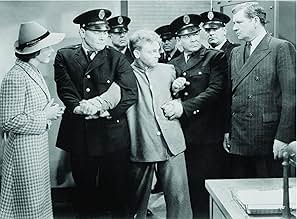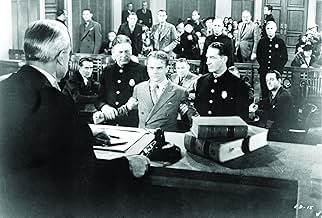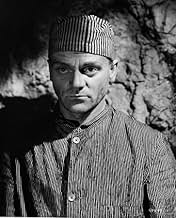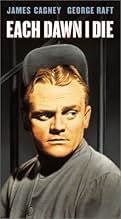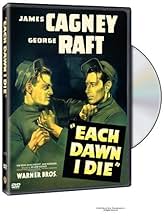IMDb रेटिंग
7.2/10
4.1 हज़ार
आपकी रेटिंग
अपनी भाषा में प्लॉट जोड़ेंA corrupt D.A. (Thurston Hall) with political ambitions is angered by news stories implicating him in criminal activity and decides to frame the reporter (James Cagney) for manslaughter in o... सभी पढ़ेंA corrupt D.A. (Thurston Hall) with political ambitions is angered by news stories implicating him in criminal activity and decides to frame the reporter (James Cagney) for manslaughter in order to silence him.A corrupt D.A. (Thurston Hall) with political ambitions is angered by news stories implicating him in criminal activity and decides to frame the reporter (James Cagney) for manslaughter in order to silence him.
- पुरस्कार
- कुल 3 जीत
William B. Davidson
- Bill Mason
- (as William Davidson)
फ़ीचर्ड समीक्षाएं
A reporter is framed and sent to prison, but with the help of a fellow con he'll try to clear his name and set things straight. That's about as far as the plot ever gets developed and it's full of holes and completely implausible events. The characters are hopelessly cliche, mostly overacted, and the melodrama of the ending goes so far over the top as to be almost laughable. And yet somehow the film has a feeling of quality and sincerity which is able to overcome all of this.
Similar to "Fugitive from a Chain Gang", this is a 1930s Warner Brothers film with a conscience, taking aim at corrupt politicians and brutal prisons. The flaws in the film are not due to lack of effort or creativity, but simply because this is the way they used to make those types of films. Jimmy Cagney and George Raft use their talent and star appeal to draw you in and keep you on the edge of your seat throughout the entire movie. It isn't necessarily a film you'd go out of your way to see, but it's definitely worth watching if you get the opportunity.
Similar to "Fugitive from a Chain Gang", this is a 1930s Warner Brothers film with a conscience, taking aim at corrupt politicians and brutal prisons. The flaws in the film are not due to lack of effort or creativity, but simply because this is the way they used to make those types of films. Jimmy Cagney and George Raft use their talent and star appeal to draw you in and keep you on the edge of your seat throughout the entire movie. It isn't necessarily a film you'd go out of your way to see, but it's definitely worth watching if you get the opportunity.
"Each Dawn I Die" is another of Warner Bros. excellent prison dramas notable mainly for the teaming of James Cagney and George Raft in the leads. It was capably directed by William Keighley.
Cagney plays crusading reporter Frank Ross who is trying to uncover political corruption. He witness key records being destroyed but before he can report what he has found he is framed by the gang for a drunk driving charge in which three people are killed. Ross is sentenced to 20 years but continues to proclaim his innocence.
On the way to prison he is handcuffed to hardened criminal Stacey (Raft) and the two soon become friends. In the prison Ross meets by the book Warden Armstrong (George Bancroft). He soon learns that the guards (John Wray, Willard Robertson) are brutal and treat the prisoners unfairly. Over time Ross realizes that his paper is not going to be able to help him. To make matters worse, the Chairman of the Parole Board (Victor Jory) turns out to be one of the people who framed him years earlier.
When Stacey's enemy Limpy Julien (Joe Downing) is murdered during a movie screening, Stacey is suspected of the crime even though he professes his innocence to Ross. However, Stacey sees this as an opportunity for escape. Because Ross has been square with him, Stacey offers to help Ross prove his innocence when he is on the outside in return for his help.
Stacey has Ross finger him as the murderer in order to force a trial during which he will escape. Unbeknownst to Stacey, Ross has contacted his newspaper whose reporters, including girlfriend Joyce Conover (Jane Bryan) show up and photograph and report Stacey's escape. The Warden finds this out and Ross is accused of aiding Stacey's escape and is sent to solitary.
Meanwhile Stacey believes that Ross has double crossed him and so has not tried to help him as he had promised. As Ross languishes in solitary, Joyce goes to Stacey to plead for his help. She tells him the truth and he finally relents and agrees to help.
Stacey's gang finds Shake Edwards (Abner Biberman) who had witnessed Ross' abduction and frame-up. Edwards fingers Polecat Carlisle (Alan Baxrer) as the culprit. However Stacey learns that Carlise is in the same prison as Ross. He then decides that the only way to get at him is to return to prison. He turns himself in and......................
Cagney and Raft play well together. Raft as the hard timer is excellent. He is the convict that everyone looks up to. Cagney's Ross is a little bewildered by it all and looks to Stacey for direction. Others in the cast include Maxie Rosenblum, Edward Pawley, Louis Jean Heydt and Stanley Ridges as various convicts and Emma Dunn as Ross' mother (another sympathetic mother character popular in many Cagney films).
The scene at the beginning of the film where Cagney is hiding in the rain is strangely reminiscent of one in "The Public Enemy" (1931).
Cagney plays crusading reporter Frank Ross who is trying to uncover political corruption. He witness key records being destroyed but before he can report what he has found he is framed by the gang for a drunk driving charge in which three people are killed. Ross is sentenced to 20 years but continues to proclaim his innocence.
On the way to prison he is handcuffed to hardened criminal Stacey (Raft) and the two soon become friends. In the prison Ross meets by the book Warden Armstrong (George Bancroft). He soon learns that the guards (John Wray, Willard Robertson) are brutal and treat the prisoners unfairly. Over time Ross realizes that his paper is not going to be able to help him. To make matters worse, the Chairman of the Parole Board (Victor Jory) turns out to be one of the people who framed him years earlier.
When Stacey's enemy Limpy Julien (Joe Downing) is murdered during a movie screening, Stacey is suspected of the crime even though he professes his innocence to Ross. However, Stacey sees this as an opportunity for escape. Because Ross has been square with him, Stacey offers to help Ross prove his innocence when he is on the outside in return for his help.
Stacey has Ross finger him as the murderer in order to force a trial during which he will escape. Unbeknownst to Stacey, Ross has contacted his newspaper whose reporters, including girlfriend Joyce Conover (Jane Bryan) show up and photograph and report Stacey's escape. The Warden finds this out and Ross is accused of aiding Stacey's escape and is sent to solitary.
Meanwhile Stacey believes that Ross has double crossed him and so has not tried to help him as he had promised. As Ross languishes in solitary, Joyce goes to Stacey to plead for his help. She tells him the truth and he finally relents and agrees to help.
Stacey's gang finds Shake Edwards (Abner Biberman) who had witnessed Ross' abduction and frame-up. Edwards fingers Polecat Carlisle (Alan Baxrer) as the culprit. However Stacey learns that Carlise is in the same prison as Ross. He then decides that the only way to get at him is to return to prison. He turns himself in and......................
Cagney and Raft play well together. Raft as the hard timer is excellent. He is the convict that everyone looks up to. Cagney's Ross is a little bewildered by it all and looks to Stacey for direction. Others in the cast include Maxie Rosenblum, Edward Pawley, Louis Jean Heydt and Stanley Ridges as various convicts and Emma Dunn as Ross' mother (another sympathetic mother character popular in many Cagney films).
The scene at the beginning of the film where Cagney is hiding in the rain is strangely reminiscent of one in "The Public Enemy" (1931).
Prison classic. Even in 1939 this must have been predictable. But James Cagney and George Raft keep this prison yarn on its feet. A top notch newspaper reporter(Cagney)is railroaded into a prison sentence on a trumped up murder charge. Even with help on the inside from a slick convict(Raft)it is just too hard to prove his innocence to the warden(George Bancroft). This busy crime drama also features: Maxie Rosenbloom, Victor Jory, Emma Dunn, Stanley Ridges and John Wray. The melodrama is a little thick and most characters are over acted, but this is still too good of a flick to pass up.
This is a great prison film--with lots of unusual twists, a great story and stellar actors. While many of the usual 1930s prison film clichés are definitely present, the overall package is so enjoyable that many will forgive its excesses. I must point out, though, that many modern audiences might laugh a bit at the dialog, but fans of Warner films of the age have come to expect and love these type films.
The movie begins with crusading reporter, Jimmy Cagney, being set up for a crime to stop him from investigating crooked public officials. On this trumped up charge, he is given a hefty prison sentence and is sent to a tough prison. On the way, he meets habitual criminal, George Raft, and they strike up a very bizarre friendship.
At first, Cagney is sure his conviction will be overturned and he's practically a model prisoner. However, after years in jail and no breaks in sight, he agrees to help Raft with a breakout and Cagney's life behind bars gets significantly worse.
Where it all goes from there you'll just need to see for yourself. However, considering that two exceptional tough guy actors head the cast (Cagney and Raft), you know this will be an exciting film--which it certainly is. Now being a Warner product, you know that the prison lingo and action will be a bit hard to believe and you know that, given a chance, Cagney will chew the scenery (he definitely does overact a bit here and there). But considering how entertaining it all is, I can certainly forgive all this. A great film for fans of old time films.
The movie begins with crusading reporter, Jimmy Cagney, being set up for a crime to stop him from investigating crooked public officials. On this trumped up charge, he is given a hefty prison sentence and is sent to a tough prison. On the way, he meets habitual criminal, George Raft, and they strike up a very bizarre friendship.
At first, Cagney is sure his conviction will be overturned and he's practically a model prisoner. However, after years in jail and no breaks in sight, he agrees to help Raft with a breakout and Cagney's life behind bars gets significantly worse.
Where it all goes from there you'll just need to see for yourself. However, considering that two exceptional tough guy actors head the cast (Cagney and Raft), you know this will be an exciting film--which it certainly is. Now being a Warner product, you know that the prison lingo and action will be a bit hard to believe and you know that, given a chance, Cagney will chew the scenery (he definitely does overact a bit here and there). But considering how entertaining it all is, I can certainly forgive all this. A great film for fans of old time films.
The main reason for watching this 1939 Warner Bros. picture is the allure of excellent ensemble performances by the cast that was assembled for it. William Keighley directed this black and white movie with great style in the way he staged the picture.
The teaming of James Cagney and George Raft proved to be an added attraction. James Cagney, who had been seen as a bad guy in most of his gangster oriented movies, plays a good guy here who ends up in jail for a crime he didn't commit. George Raft practically steals the movie and makes it his own. The chemistry between both stars is what makes the movie work. It was notorious how both Mr. Cagney and Mr. Raft enjoyed working with one another, and it translates to what one sees in the finished product.
The other great asset going for "Each Dawn I Die" is the strong ensemble cast that was put together to support the principals. George Bancroft, Max Rosenbloom, John Wray, Victor Jory and Edward Pawley are seen doing incredible work. Jane Bryan plays Joyce Conover, the good girl who believes in the innocence of her boyfriend and fights for his release.
Even though some aspects of the film are far fetched, it involves the viewer like other films of this genre thanks to the direction of Mr. Keighley and the excellent work he got out of his cast and crew.
The teaming of James Cagney and George Raft proved to be an added attraction. James Cagney, who had been seen as a bad guy in most of his gangster oriented movies, plays a good guy here who ends up in jail for a crime he didn't commit. George Raft practically steals the movie and makes it his own. The chemistry between both stars is what makes the movie work. It was notorious how both Mr. Cagney and Mr. Raft enjoyed working with one another, and it translates to what one sees in the finished product.
The other great asset going for "Each Dawn I Die" is the strong ensemble cast that was put together to support the principals. George Bancroft, Max Rosenbloom, John Wray, Victor Jory and Edward Pawley are seen doing incredible work. Jane Bryan plays Joyce Conover, the good girl who believes in the innocence of her boyfriend and fights for his release.
Even though some aspects of the film are far fetched, it involves the viewer like other films of this genre thanks to the direction of Mr. Keighley and the excellent work he got out of his cast and crew.
क्या आपको पता है
- ट्रिवियाAccording to a series of contemporary articles in the "Los Angeles Times" and the "New York Times", Warner Bros. bought the rights to Jerome Odlum's 1938 novel of the same title as a vehicle for James Cagney with Edward G. Robinson to co-star. Robinson was then replaced by John Garfield, and Michael Curtiz was to direct. Eventually, Curtiz was replaced by William Keighley, and Fred MacMurray was to replace Garfield in the reporter's role. When MacMurray became unavailable, a screen test with Jeffrey Lynn was made. Finally, Raft was signed and swapped roles with Cagney, so Raft became the gangster and Cagney the reporter.
- गूफ़The conversation in the prison yard between Ross and Fargo Red, concerning dogs not having pores, is unrealistic. The slow-witted Red would surely have heard the word as "paws". As such he would not then have asked "How do they sweat?"
This is an "Unacceptable Goof" per IMDb Guidelines as it's a "Personal Opinion" ("Do not include your own opinions") that does not allow for "Artistic License" ("Please allow for artistic license on the part of the filmmakers. Most movies and shows are not meant to perfectly reflect reality as you experience it.")
- भाव
'Hood' Stacey: So, how tough are you, babe?
- कनेक्शनFeatured in Hollywood: The Great Stars (1963)
- साउंडट्रैकDon't Give Up the Ship
(1935) (uncredited)
Music by Harry Warren
Played by the band in the theater before the showing of the movie
टॉप पसंद
रेटिंग देने के लिए साइन-इन करें और वैयक्तिकृत सुझावों के लिए वॉचलिस्ट करें
- How long is Each Dawn I Die?Alexa द्वारा संचालित
विवरण
- रिलीज़ की तारीख़
- कंट्री ऑफ़ ओरिजिन
- भाषा
- इस रूप में भी जाना जाता है
- Muero cada amanecer
- फ़िल्माने की जगहें
- उत्पादन कंपनियां
- IMDbPro पर और कंपनी क्रेडिट देखें
बॉक्स ऑफ़िस
- बजट
- $7,35,000(अनुमानित)
- चलने की अवधि
- 1 घं 32 मि(92 min)
- रंग
- पक्ष अनुपात
- 1.37 : 1
इस पेज में योगदान दें
किसी बदलाव का सुझाव दें या अनुपलब्ध कॉन्टेंट जोड़ें


